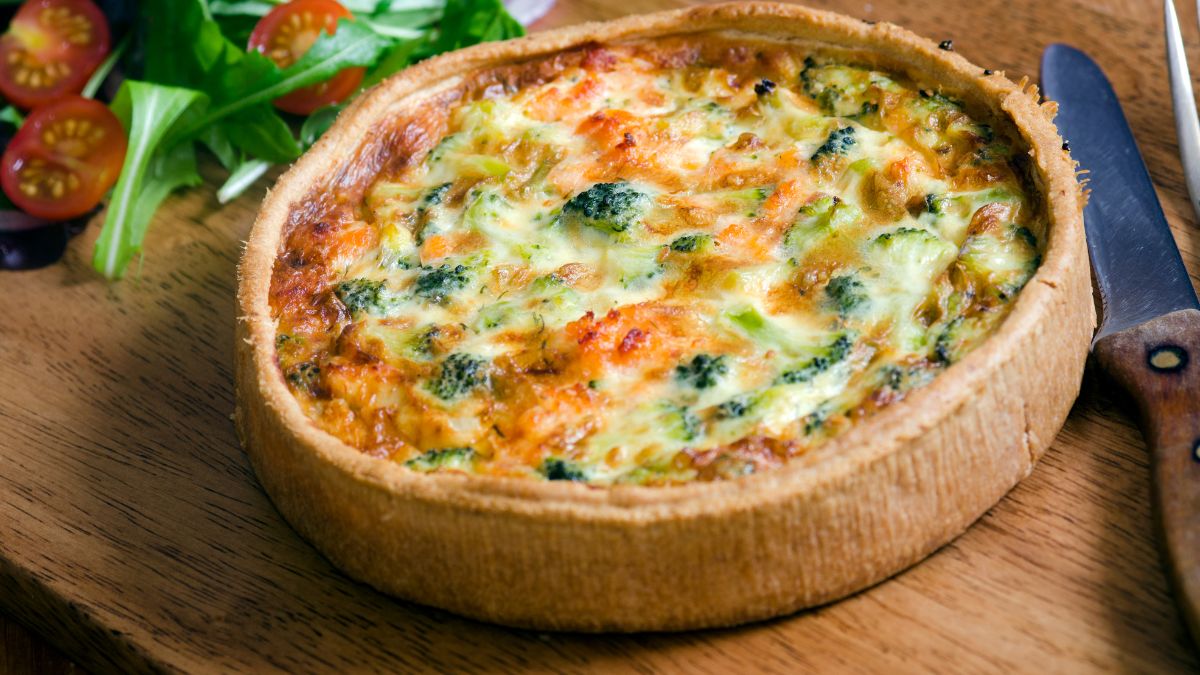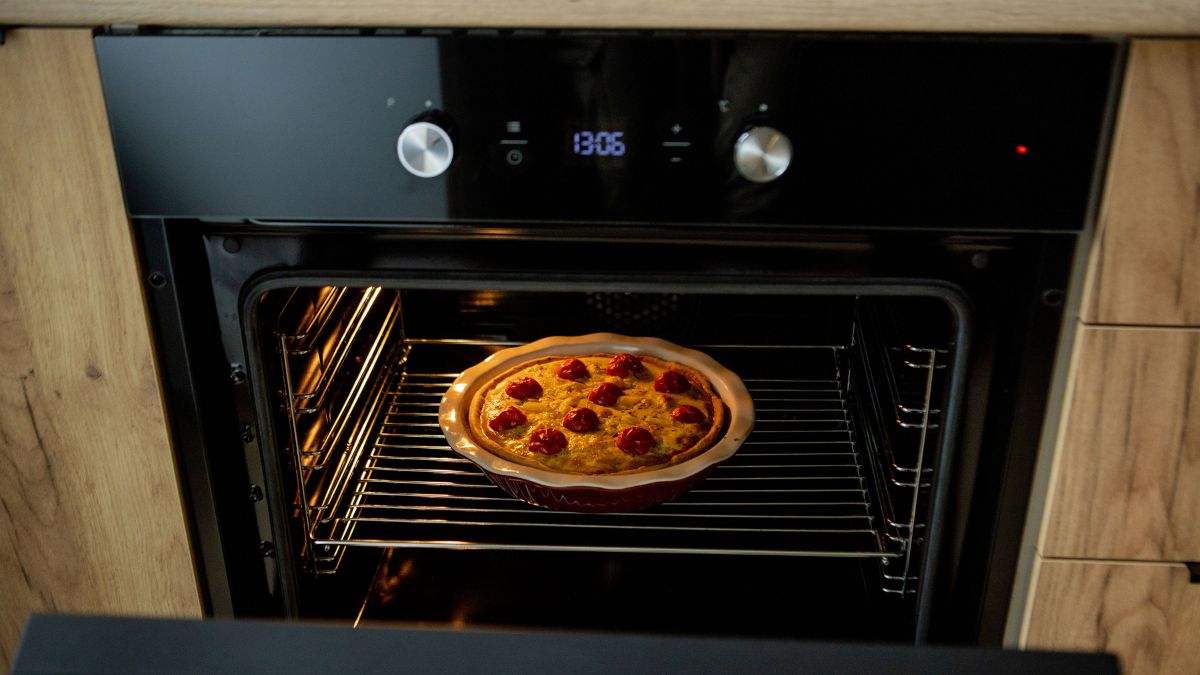Do You Eat Quiche Hot or Cold? [ + 4 Reheating Methods]

Quiche is a dish that can be prepared according to anyone’s wishes. Its convenience to be frozen and pulled out anytime you want something delish to eat makes a good topic to discuss the serving methods. You can serve it as a delicacy or easy go-to food, alone or with a side, but one question remains: Do you eat quiche hot or cold?
You can eat quiche either hot or cold, but it’s undoubtedly more appetizing when served warm. You can make it beforehand and heat it later in the oven, air fryer, stovetop, or microwave.
When I don’t have a clue what to serve, I usually go for a quiche. Served as breakfast or dinner, even a fancy brunch, you won’t miss as it can blend with any occasion. Keep reading to get some ideas on how to reheat it and what to serve it with, so you can make a stock and pop it out of the freezer when craving it.
How to Serve Quiche, Hot or Cold?
You can eat quiche either completely cold, slightly warm, or burning hot, based on your preference. There is always but, though. Cold quiche is quite tasteless, but, what’s most important, it is safe to eat. Cold quiche tends to have a mushy crust and leathery texture overall.
To save you from eating soggy quiche at work, here are some tips. Be careful which ingredients you choose for your stuffing. For example, opt for less-juicy vegetables, like spinach, peas, potatoes, sweet potatoes, or carrots, instead of tomatoes, zucchini, mushrooms, or broccoli.
Hot quiche has a crunchy and buttery texture at the same time. The crust in question contains loads of butter, which gives it flaky and lightweight layers. You can reach that consistency only with hot or warm quiche.
Don’t forget to wait between 10 and 20 minutes for the quiche to sit before cutting. That way you will have clean cuts, and the crust won’t crumble. Plus, you’ll get an ideal serving temperature, not too hot but warm.
How to Reheat Quiche?
If you have frozen quiche on your hands, thaw it step by step. Place it in the fridge, not at room temperature, for safety reasons, to defrost because it involves a diary. A plus tip for the finest taste: always leave the quiche at room temperature for about 20 minutes while your oven is preheating. This is because the butter in the crust will gradually soften.
There are many ways to reheat this dish and keep its signature texture. Read on to get some ideas with pros and cons so you can choose your favorite.
Oven
An oven is the most logical solution when you want to serve premade quiche as freshly made. The oven will ensure you equally distributed heat and crunchy crust. Moreover, it will make your whole house smell divine.
The optimal temperature for warming is about 350°F for 15 minutes while the internal temperature should be 165°F. You can protect it with aluminum foil to prevent it from getting charred and dry. If you still want crusty dough and topping, remove the foil a few minutes prior to taking it out from the oven till golden brown.
When it comes to choosing the right container for heating, opt for a simple baking sheet. You can use parchment paper, but it’s not mandatory as the dough contains shortening and won’t stick to the metal even without greasing it.
The only flaw of this method is it takes a little longer to heat, plus you have to wait for it to rest for about 15 minutes to slice it up. Also, if you don’t set the temperature right or leave it too long, it will be dry and rigid.

Stovetop
You can reheat your quiche on the stovetop, too. It is a bit trickier than other methods, but it is simpler to handle if cut into pieces. You’ll need one pan and one butter cube, so you’ll have a crispy and sapid dish.
Bring it to medium heat and put a slice of your quiche in for about 5 minutes. Reduce your temperature to the low to prevent it from burning, leaving it for 3 minutes on the other side. That way, you’ll get an evenly heated piece of pastry.
Microwave
Microwaved food surely has the blandest taste among all of the heating options. On the other hand, it is doubtlessly the most convenient method. Just pop the quiche in a microwave-friendly dish and heat it on a medium for 1 minute.
For the best result, heat it piece by piece. If you try to microwave the big pieces, you will get a quiche that is hot on the inside and cold on the outside. You can even cut the whole piece into bites and make the reheating even faster.
The same rule applies here, too – bring it to 165°F of internal temperature. It will heat evenly, yet you’ll have no crunchiness whatsoever. Remember to remove the foil before microwaving it.
Microwaved quiche will be as soft as your ingredient are watery. Juicy ingredients will provide you with spongy consistency. It can keep a bit of crispiness, though, if you heat it for a short period. The longer it’s heating, the moister it will be.

Air Fryer
To use an air fryer, you’ll need slices, of course, as it won’t fit as a whole. However, this is a better option than the microwave. It’s a convenient and definitely faster option than the oven.
You’ll need about 5 minutes of heating at 300°F. It will heat the quiche evenly, but it can become a bit dry, no question. Check it regularly or wrap it in aluminum foil to prevent drying, but unwrap in the last minutes to still get crusty ends.
How to Keep Quiche Warm For a Party?
The easiest way to keep quiche warm is to cover it with a lid or layers of aluminum foil. Couple it with wrapping the container in a towel so you’ll extend its warmth to the maximum. That way it will get cold moderately, but it’s not a permanent solution.
For something more effective, choose a warming tray. If you’re hosting parties on regular bases, invest in one of them as they will save you a lot of time. For a DIY warm tray, use hot bricks or hot water bottles under the metal dishes. For a step further, use an electric blanket or a heating pad. Those options will provide you a low but constant heat, which is enough to keep it warm but not cooking.
If you don’t need your food on a display, keep it in the oven at low. Leave the oven at 200°F, not a degree more, so it wouldn’t dry out. The oven will keep it warm equally, and you can keep it covered with foil, too, just to be sure.
Another great kitchen gadget is a slow cooker. You can keep your quiche there at a low temperature without worrying if it’s going to dry out as it has a lid. It will stay warm and moist, but you’ll probably have to slice it up in advance as it can be too big to fit in a crock pot.
What to Serve With Quiche?
What to serve with quiche depends solely on what filling you’re using and for which meal you’re serving it.
If you made a quiche with a hearty filling, to contrast it, choose light green salad as a side. Mix some iceberg salad, arugula, cucumber, a few strawberries for a kick of sweetness, and some goat cheese. Keep it simple with the dressing, like olive oil, lemon, and Aceto balsamico.
Another option for a salad is a combination of spinach, artichokes, bell peppers, and caramelized onions for a contrast. You can still add some berries or grapes for a bit of tanginess. Squeeze a lime over, and enjoy!
When you don’t feel like mixing too many flavors, serve green beans as a side. Just simple, blanched beans with a few almonds for a touch of crunch and lemon for sourness. Its balmy flavor will pair well with a well-seasoned quiche option.
Piquant tomato soup will pair exquisitely with spinach or potato quiche. Especially if you opt to serve quiche cold or slightly warm, hot soup is just a contrast you need. If you’re serving it for breakfast, you can choose from pancakes and granola as a sweet side to fried bacon for saltiness.
What Potatoes to Serve With Quiche?
Roasted mini potatoes are the easiest and fastest to make. Leave them in the skin, sprinkle with olive oil, salt, and rosemary and toss them in the oven or air fryer. For more different flavors, make jacket potato and fill it with cheese and sweet corn.
The puree is probably a cliché, but something you’ll never go wrong with. If you want some crunch, opt for regular or sweet potato fries. Add some sourness with creamy dip, and you have all the senses covered.
If you don’t hate grating, make hash browns. You can toast or fry them for more crumbliness. For an easier and healthier version, make mashed potatoes you can bake in the oven with a few drops of olive oil.
